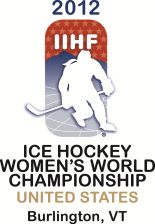BURLINGTON – The United States kicks off its attempt to “four-peat” in Vermont tonight by playing Canada on the first day of the 2012 IIHF Ice Hockey Women's World Championship. It marks the first time since 2009 the teams have met in a non-medal game, and we have a new and exciting tournament format to thank as the hosts look to win gold as they have in 2011, 2009, and 2008.
As always, there are eight teams divided into two groups, but the groups are stacked rather than parallel. That is, Group A features the top four ranked teams from last year and Group B the bottom four. Each team plays a round robin within its group, but all teams from A advance to the playoffs while only the top two from B advance.
The bottom two teams in B will then play a best-of-three relegation round, the loser going down to Division I for 2013. The top two teams in A advance to the semi-finals, while the bottom two in A and top two in B play a crossover quarter-finals.
Why the change? Well, for starters, it eliminates the top teams in Group A from playing the bottom two teams in Group B, games which in the past have often lacked competitive spectacle. It also allows fans to get two games, not one, between the top teams in Group A while still providing what should be entertaining quarter-finals match-ups.
And lastly, it gives Canada and the United States a bit of extra incentive in their early game. The winner likely will go to the semis, but the loser will face a must-win game a day later or face the distinct possibility of finishing third or fourth in Group A, meaning a possible semi-finals date with the Group A winner and creating a gold-medal game which doesn’t feature Canada and the United States.
Another wrinkle to the format this year is that Sweden is in Group B. The Swedes finished fifth last year thanks to a perfect storm in which the Finns had a slow start and finished behind to the Swiss in the preliminary round but then beat Sweden 5-1 in the semis, forcing Sweden to play in the fifth-place game and not for the bronze.
As a result, the Swedes, if they can reclaim their place in the top four, might create a difficult situation for one of the other top teams come the quarter-finals (which they will likely qualify for as one of the top two teams in Group B).
All in all, the format change shakes things up a bit and creates more balanced games while adhering to an eight-team tournament.
ANDREW PODNIEKS |







